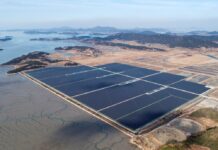
Minister of Trade, Industry and Energy Joo Hyunghwan (left) and Vice President of the Asia Society’s Policy Institute and former senior U.S. trade official Wendy Cutler shake hands, as former chairman of AMCHAM Jeffrey Jones (center) looks on, during the Korea-U.S. FTA fifth anniversary seminar in Seoul on March 14.
Five years have passed since the implementation of the Korea-U.S. Free Trade Agreement (KORUS FTA), with favorable outcomes for both trade partners.
The Ministry of Trade, Industry and Energy (MOTIE) announced on March 15 that the trade in commodities between the two countries has maintained, on average, a 1.7 percent annual growth rate over the past five years. The KORUS FTA went into force on March 15, 2012.
Despite a weakening global economy, the partners were able to keep trade flows on an upward trajectory. According to the World Trade Organization (WTO), the volume of world trade dropped from USD 18.3 trillion in 2011 to USD 16.5 trillion in 2015. During the same period, Korea-U.S. trade saw a 15 percent increase, moving from USD 100.1 million in 2011 to USD 115.2 million in 2015.
According to the MOTIE, Korea’s exports to the U.S. increased 3.4 percent on average from 2012 to 2016. Industries such as automobiles (12.4 percent), automobile parts (4.9 percent), semiconductors (4.2 percent) and motors and pumps (7.7 percent) led the exports. The KORUS FTA tariff reduction guidelines didn’t include automobiles until 2015, but quality improvements and an increase in U.S. private spending led to an increase in exports.
Korean imports from the U.S., meanwhile, showed a slight downturn. According to the Korea Customs Service (KCS), imports from the U.S. were at USD 43.22 billion in 2016, down 0.6 percent from USD 44.57 billion in 2011, before the implementation of the KORUS FTA. During the same period, the world’s import volume dropped 5 percent on average, from USD 524.41 billion in 2011 to USD 445.7 billion in 2016.
In the services sector, the expansion of products and the exchange of human resources resulted in an 8.8 percent increase over four years from 2012 to 2016. During the same period, Korean service exports increased 8.1 percent on average. Transportation services (13 percent), travel (13.3 percent), as well as R&D, legislation and auditing (23.4 percent) were largely responsible for the increases in exports. Imports from the U.S. also saw an increase of 9.2 percent on average. Industries covered included intellectual property (42.3 percent), telecommunications (38.8 percent), as well as R&D, legislation and auditing (4.9 percent).
Increases in trade as a result of the KORUS FTA subsequently led to the creation of jobs and economic growth. Korean investment in the U.S. between 2012 and 2016 amounted to USD 36.97 billion, a 60.1 percent increase compared to USD 23.01 billion of investment between 2007 and 2011. Last year alone, investments soared to a record high of USD 12.9 billion. The expansion of Korean firms like Hyundai Mobis, LG Chem, and POSCO into the U.S. Midwest, as well as investments in factories and energy development, is believed to have helped boost America’s manufacturing sector.
U.S. investment in Korea showed significant increase as well, with USD 20.16 billion invested between 2012 and 2016. This is a more-than-2.1-times increase from USD 9.49 billion between 2007 and 2011. In 2015, investments were at a record high of USD 5.48 billion. Korea-U.S. investments, which had been focused on finance, insurance, electronics, retail and wholesale businesses before the KORUS FTA, were expanded into new industries such as IT and biotech.

Minister of Trade, Industry and Energy Joo Hyunghwan stresses the importance of strengthening cooperation on trade, using the Korea-U.S. Free Trade Agreement as a platform, during the Korea-U.S. FTA fifth anniversary seminar in Seoul on March 14.
“The FTA signed between the U.S. and Korea was one of the most comprehensive agreements that the U.S. negotiated with an overseas trade partner,” said Vice President of the Asia Society’s Policy Institute and former senior U.S. trade official Wendy Cutler. “The agreement may not be perfect, but it provides a good example to other countries around the world. The deficits in trade are a result of macroeconomic factors at play. Since the implementation of the KORUS FTA, imports have decreased in the U.S. as well, leading to deficits. However, this is a due to the global economic recession, not a result of the KORUS FTA,” she said.
By Lee Hana
Korea.net Staff Writer
Photos: MOTIE
hlee10@korea.kr























